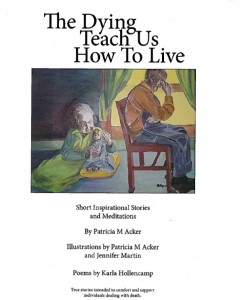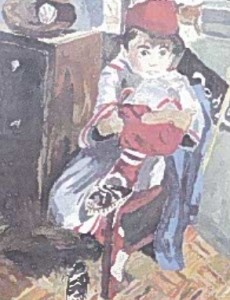Meet the Author: Patricia Acker

Book cover.
Ohio Social worker Patricia Acker has worked in hospice care for 17 years. She discovered she often learned important lessons about hope, resiliency and spirituality from her clients.
Acker, MS, LSW, decided to write about her experiences in a self-published book, “The Dying Teach Us How to Live” (Greyden Press, 2013).
Acker, who is a member of the National Association of Social Workers, changes names and details of her accounts to protect the privacy of clients and friends. Still the stories are powerful.
For instance, she wrote about a 16-year-old cheerleader who had leukemia and was taking heavy doses of morphine. Despite her illness, the young woman wanted to just be a teenager and spend her last two weeks of life in school.
“She was brave, bold and inspiring,” Acker wrote. “Fortunately her family realized this was something she needed to do and they facilitated her daily journey to school with all of her medications and medical precautions.”
SocialWorkersSpeak.org sat down with Acker to learn more about her career and book.
Q: Tell us about yourself. When did you decide to become a social worker and where did you study?
Acker: Due to my love of people, I chose the social work profession. I entered Wright State University (WSU) for my bachelor’s degree. I studied for 15 years while working, getting married and raising four children. When I became divorced, I needed one quarter of school to graduate. I was able to get a scholarship to complete my final quarter. I taught childbirth and breastfeeding classes while I attended school and was involved with families when the normally happy experience of a birth changed if their baby died before, during,or after the birth. My first social work position was with a hospice where I assisted with dying children, teens and adults. These courageous people gave me more than I was able to give them with their example of dignity and faith during times of immense upheaval.
Q: Why did you decide to write a book? And what have your clients taught you about dying and death?
Acker: My niece died of crib death at age three months, my father died at age 54 from a car accident and my brother-in-law died 10 days later at age 32 from a work accident. I was devastated and had nowhere to turn for emotional and grief support. I wanted others to have healing grief options and decided hospice was where I belonged. Hospice patients, their family and friends shared many amazing stories about angels, near-death experiences, forgiveness, love, faith and hope. I comforted other hospice individuals with these stories and they told me, “You need to write a book.” They were my teachers about living life one day at a time and making time on this earth meaningful. I learned about unconditional love and the unselfish ongoing services provided by caregivers. Death makes life purposeful and precious because without death, we would not appreciate life.

Patricia Acker
Q: Did you do all the illustrations in the book?
Acker: I have more than 70 of my own illustrations and four completed by my daughter, Jen.
Q: Is America’s attitude toward death changing?
Acker: Americans today seem to be more open to the ideas of death, faith, angels, near-death experiences and Heaven.

Christopher’s Best Friend watercolor painting from “The Dying Teach Us How to Live.” Photo courtesy of Patricia Acker.
Q: You said children often have a better attitude toward death. Why?
Acker: The innocence of dying children allows them to be especially open to spiritual experiences, and they are often ready to die before family are accepting of his or her terminal condition. I have covered issues such as suicide, war, and accidents because these deaths have significant impact on all of us.
Q: How do you hope your book is used?
Acker: I hope that my book will be able to lessen the fear and anxiety of the dying experience and will increase feelings of faith, peace and hope. I encourage patients to utilize hospice services through a chapter devoted to hospice.
Q: What has been the reaction to your self published book from the public?
Acker: I have had many positive letters from individuals who have found serenity from reading these short stories of inspiration. I want to share with you what two readers sent me. Aileen Adams, a master’s prepared social worker, said, “Your book is a gift of love to everyone who reads it!” And Lorna Stayton in Eldorado, Ohio, wrote, “Congratulations on your book! It is outstanding! You have captured the expressions of love that bring love, joy and peace to the sick and dying. This inspires us to do the same in our day to day life. The essence of God throughout the book touched my soul. Your fantastic art work added much to the book. Thank you for sending me the book and signing it!”
You can watch a video Patricia Acker discussing her book. Acker and other social workers help clients understand and deal with the processes of dying and grief. To learn more visit the National Association of Social Workers’ “Help Starts Here” Death and Dying” website.
| Leave A Comment
Advertisement
Leave a Comment
You must be logged in to post a comment.


